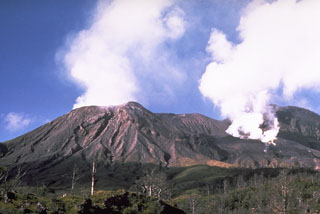Report on Langila (Papua New Guinea) — July 2000
Bulletin of the Global Volcanism Network, vol. 25, no. 7 (July 2000)
Managing Editor: Richard Wunderman.
Langila (Papua New Guinea) Forceful ash emissions on 5 and 9 April rise 1-2 km
Please cite this report as:
Global Volcanism Program, 2000. Report on Langila (Papua New Guinea) (Wunderman, R., ed.). Bulletin of the Global Volcanism Network, 25:7. Smithsonian Institution. https://doi.org/10.5479/si.GVP.BGVN200007-252010
Langila
Papua New Guinea
5.525°S, 148.42°E; summit elev. 1330 m
All times are local (unless otherwise noted)
This report covers April through June 2000. Activity remained at a low level in April. From visual observation reports received only up to 9 April, Crater 2 periodically gently released moderate to thick ash clouds. However, on 5 and 9 April, the ash clouds were released more forcefully and with rumbling sounds. These ash clouds rose 1-2 km above the summit before being blown SE. Crater 3 released light white vapor throughout the month.
Visual observations were next reported after 16 June. Crater 2 produced thick, white ash clouds in moderate volume. On 23 and 24 June, these clouds were accompanied by blue vapor. On 16 and 18 June, rumbling noises were heard. Crater 3 was inactive in June with the exception of a weak trail of thin white vapor escaping on 16 June.
The seismograph remained non-operational throughout the entire reporting period.
Geological Summary. Langila, one of the most active volcanoes of New Britain, consists of a group of four small overlapping composite basaltic-andesitic cones on the lower E flank of the extinct Talawe volcano in the Cape Gloucester area of NW New Britain. A rectangular, 2.5-km-long crater is breached widely to the SE; Langila was constructed NE of the breached crater of Talawe. An extensive lava field reaches the coast on the N and NE sides of Langila. Frequent mild-to-moderate explosive eruptions, sometimes accompanied by lava flows, have been recorded since the 19th century from three active craters at the summit. The youngest and smallest crater (no. 3 crater) was formed in 1960 and has a diameter of 150 m.
Information Contacts: I. Itikarai, D. Lolok, K. Mulina, and F. Taranu, Rabaul Volcano Observatory (RVO), P.O. Box 386, Rabaul, Papua New Guinea.

